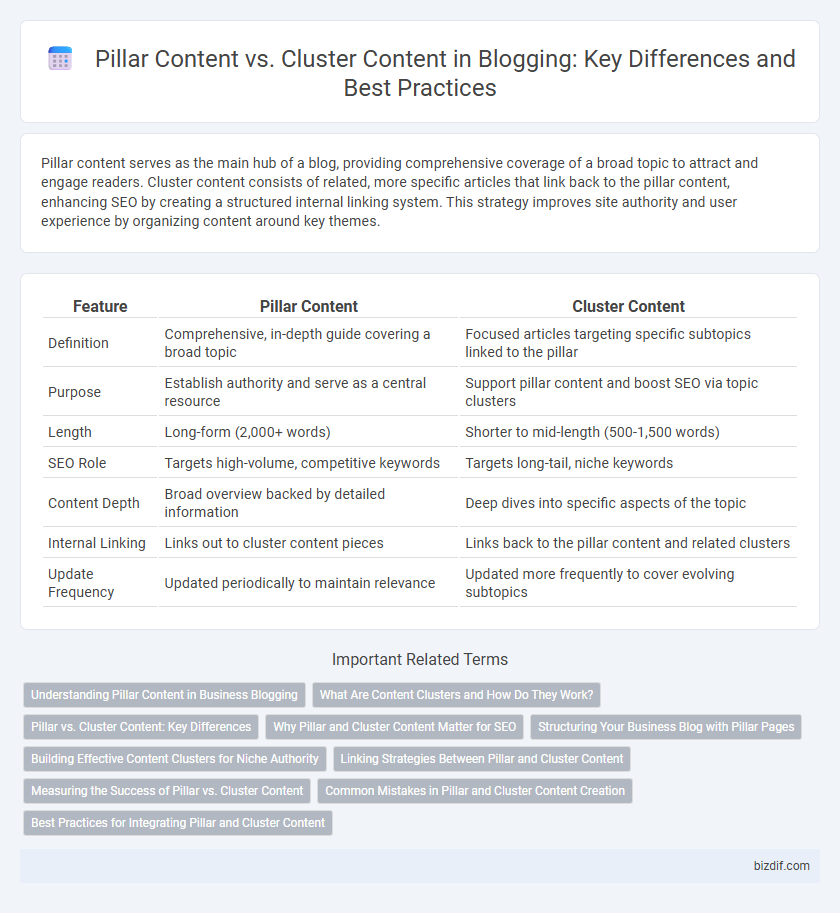Pillar content serves as the main hub of a blog, providing comprehensive coverage of a broad topic to attract and engage readers. Cluster content consists of related, more specific articles that link back to the pillar content, enhancing SEO by creating a structured internal linking system. This strategy improves site authority and user experience by organizing content around key themes.
Table of Comparison
| Feature | Pillar Content | Cluster Content |
|---|---|---|
| Definition | Comprehensive, in-depth guide covering a broad topic | Focused articles targeting specific subtopics linked to the pillar |
| Purpose | Establish authority and serve as a central resource | Support pillar content and boost SEO via topic clusters |
| Length | Long-form (2,000+ words) | Shorter to mid-length (500-1,500 words) |
| SEO Role | Targets high-volume, competitive keywords | Targets long-tail, niche keywords |
| Content Depth | Broad overview backed by detailed information | Deep dives into specific aspects of the topic |
| Internal Linking | Links out to cluster content pieces | Links back to the pillar content and related clusters |
| Update Frequency | Updated periodically to maintain relevance | Updated more frequently to cover evolving subtopics |
Understanding Pillar Content in Business Blogging
Pillar content serves as the foundational, comprehensive resource in business blogging, covering core topics that define a brand's expertise and target audience. It is typically longer, detailed, and designed to drive significant organic traffic while supporting SEO strategies by linking to related cluster content. Effective pillar content enhances site authority, improves user navigation, and establishes a centralized hub for in-depth knowledge within a business niche.
What Are Content Clusters and How Do They Work?
Content clusters are strategically organized groups of interrelated blog posts centered around a single pillar topic, enhancing website structure and SEO by creating a comprehensive network of content. Each cluster content piece targets specific subtopics, linking back to the pillar content to boost domain authority and improve search engine rankings. This approach helps search engines understand site hierarchy and relevance, driving more targeted organic traffic and increasing user engagement.
Pillar vs. Cluster Content: Key Differences
Pillar content serves as a comprehensive, authoritative guide on a broad topic, designed to attract significant organic traffic and establish site authority, while cluster content focuses on narrower, related subtopics that link back to the pillar page, enhancing SEO through topic interconnectivity. Pillar content typically covers extensive keyword themes and provides in-depth information, whereas cluster content targets long-tail keywords and supports the pillar with detailed insights or specific aspects. This strategic relationship improves site structure, boosts search rankings, and drives higher user engagement by organizing content around core topics and their relevant subtopics.
Why Pillar and Cluster Content Matter for SEO
Pillar content serves as the authoritative foundation on a core topic, organizing related cluster content that targets specific subtopics to enhance site structure and keyword relevance. This strategic linking between pillar and cluster content boosts search engine visibility by improving crawlability and demonstrating topical expertise. Effective use of pillar and cluster content increases organic traffic and helps establish higher rankings in search engine results pages (SERPs).
Structuring Your Business Blog with Pillar Pages
Structuring your business blog with pillar pages enhances SEO by organizing content into clear topic clusters centered around core themes. Pillar content serves as comprehensive guides that link to cluster content, which targets specific subtopics and keywords, improving user experience and search engine crawlability. This strategy increases organic traffic by establishing authority and boosting relevancy across interconnected blog posts.
Building Effective Content Clusters for Niche Authority
Building effective content clusters enhances niche authority by creating a well-structured network of pillar content and related cluster content. Pillar content covers broad topics comprehensively, while cluster content dives into specific subtopics, linking strategically to strengthen SEO and user engagement. This interconnected strategy improves search rankings and establishes a website as an authoritative source within its niche.
Linking Strategies Between Pillar and Cluster Content
Effective linking strategies between pillar and cluster content enhance site architecture by creating clear pathways for search engines and users. Pillar content serves as the authoritative guide, linking out to multiple cluster articles that dive deeper into subtopics, while each cluster article links back to the pillar to reinforce topical relevance. This interlinking improves SEO by distributing link equity, increasing dwell time, and signaling content hierarchy within a niche.
Measuring the Success of Pillar vs. Cluster Content
Measuring the success of pillar content involves tracking organic traffic, keyword rankings, and the authority it builds across multiple related topics, reflecting its role as a comprehensive resource. Cluster content success is evaluated by analyzing engagement metrics, internal link efficacy, and how well each piece supports and drives traffic back to the pillar content. Using tools like Google Analytics and SEO platforms helps quantify the impact of both content types on overall site performance and search visibility.
Common Mistakes in Pillar and Cluster Content Creation
Common mistakes in pillar and cluster content creation include failing to maintain clear topic relevance, causing confusion and poor SEO performance. Overloading cluster content with keywords reduces readability and user engagement, while inconsistent internal linking weakens topic authority and search rankings. Optimizing content by aligning clusters to a well-defined pillar page and ensuring natural, user-focused language improves search engine visibility and audience retention.
Best Practices for Integrating Pillar and Cluster Content
Effective integration of pillar and cluster content involves creating a comprehensive pillar page that covers broad topics with in-depth information, supported by cluster articles targeting specific subtopics linked internally to enhance SEO. Using strategic keyword mapping ensures that cluster content complements the pillar page, improving topical authority and user navigation. Regularly updating both pillar and cluster pages with relevant data and maintaining consistent interlinking maximizes search engine visibility and user engagement.
Pillar content vs cluster content Infographic

 bizdif.com
bizdif.com